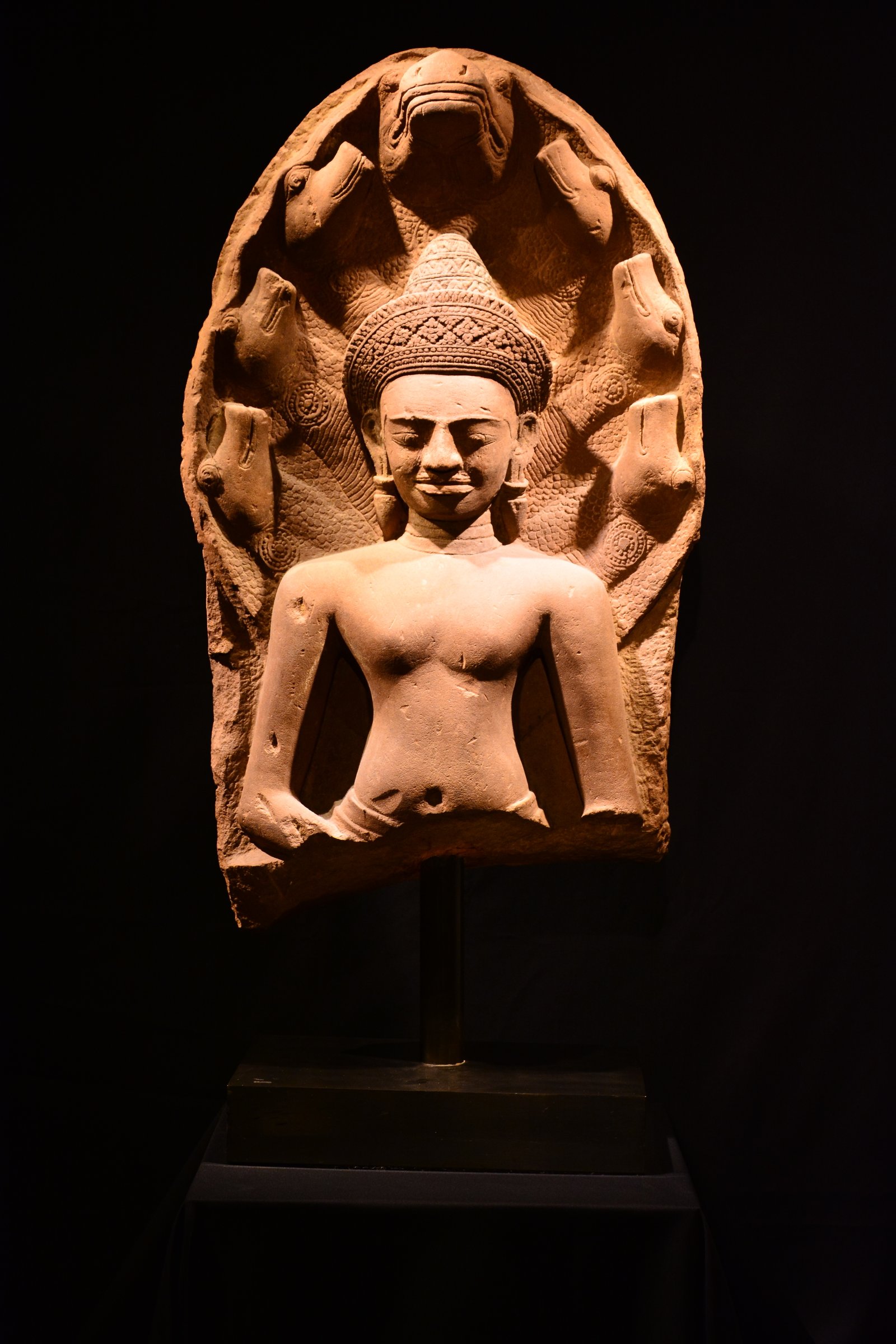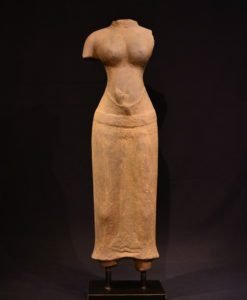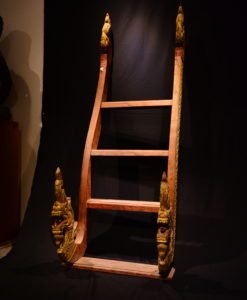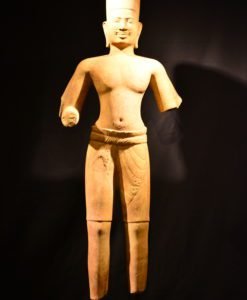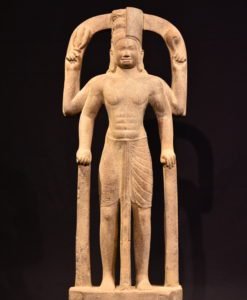Angkor Wat Period Sandstone Buddha Relief Carving Sheltered by Naga – 77 cm
This exquisite sandstone relief carving, measuring 77 cm in height, 45 cm in width, and 18 cm in depth, exemplifies the refined and symbolic art of the Angkor Wat period.
ITEM DESCRIPTION
The depiction of the Buddha sheltered by a Naga, a multi-headed serpent, is a theme common in Southeast Asian Buddhist art, symbolizing both protection and reverence. This statue, believed to have originated from a larger architectural context—likely a temple or shrine—was likely part of an intricate wall or doorway that adorned the sacred spaces where the faithful gathered.Origin: Cambodia
Period: Angkor Wat
The Buddha and the Naga: Symbolism and Representation
The Buddha, with a serene expression and meditative posture, is depicted under the protective hood of a Naga with seven heads, the central head raised above the others. This arrangement is significant, as the Naga’s multi-headed form is a unique interpretation of the guardian serpent found in many depictions of the Buddha’s life and teachings. The Naga’s role in these images is not only as a symbol of protection but also as a representation of the power and cosmic forces of nature. In Southeast Asian traditions, Nagas are revered as protectors, often seen guarding sacred spaces such as temples and Buddha statues.
The Naga’s presence in this relief emphasizes the divine protection the Buddha enjoys, even as he meditates on profound truths. The seven-headed Naga is an intriguing variation of the typical Naga depictions found in other works of the period, making this sculpture particularly unique. The major head at the top middle of the Naga highlights the central figure’s importance and further enhances the sense of sacred protection surrounding the Buddha.
Angkor Wat Period Artistic Elements
This piece is a prime example of the art produced during the Angkor Wat period, a time marked by the grandeur of monumental architecture and the flourishing of both Hindu and Buddhist artistic expressions. The Angkor Wat period, spanning from the early 12th century under King Suryavarman II, saw a refined style that blended intricate carvings, balanced compositions, and symbolic representations of both divine figures and celestial forces.
The relief carving’s simplicity of line, coupled with the use of smooth sandstone, reveals the masterful craftsmanship of the time. While the carving may lack the elaborate surface detail seen in some other Angkor Wat sculptures, the absence of heavy ornamentation on the Buddha’s figure and the stylized portrayal of the Naga suggest a transitional style that was prominent during this period. The smooth texture of the statue, likely a result of ritual use where hands frequently touched the surface, also adds a sense of tactile intimacy to the piece.
Cultural and Architectural Context
This relief was likely part of a much larger architectural element, such as a temple wall or doorway, and possibly one of the many Buddhist or Hindu temples built during the Angkor Wat period. The relief style is consistent with other architectural decorations from this time, where sculptures were often integrated into the building’s framework, elevating the sanctity of the space. These sculptures were not merely decorative but served as symbols to sanctify the area and protect those who entered.
The depiction of the Buddha under the Naga was common in both religious and royal contexts, where the image of the Buddha’s transcendence was often emphasized with celestial beings such as Nagas watching over him. This motif was not only a religious expression but a political one as well, signifying the divine right of rulers who commissioned such works to assert their protection under the divine.
A Unique Legacy from the Local Governor’s Collection
This particular statue has a fascinating provenance. It was originally part of the legacy passed down by the local governor’s family, further elevating its cultural and historical value. Such pieces of cultural heritage are treasures of both artistic and historical significance. The relief is a beautiful representation of Khmer craftsmanship and religious symbolism, passed from generation to generation, and now offered for those who wish to own a piece of history from the golden age of the Khmer Empire.
Preserving the Art of the Angkor Wat Period
This Buddha relief sculpture is a remarkable piece for any collector or connoisseur of Southeast Asian art. It offers a rare glimpse into the rich history of Khmer sculpture, reflecting both religious devotion and the technical artistry of the Angkor Wat period. The seven-headed Naga, the bare torso of the Buddha, and the finely preserved sandstone surface combine to make this piece a valuable asset for anyone interested in the spiritual and cultural heritage of Southeast Asia.
References:
-
Coedès, G. (1968). The Indianized States of Southeast Asia. University of Hawaii Press.
-
Kulke, H. (2004). The History of India. Routledge.
-
Freeman, M., & Jacques, C. (2007). Angkor: A Guide to Cambodia’s Wondrous Temples. Thames & Hudson.
-
Vickery, M. (2000). The Archaeology of Mainland Southeast Asia. Cambridge University Press.
PRODUCT DETAIL
Medium: Sandstone
Dimensions:
Height 77 cm
Length 18 cm
Wide 45 cm
Condition Report: –
Please keep in touch for Price and more information: Mallika1013@gmail.com



